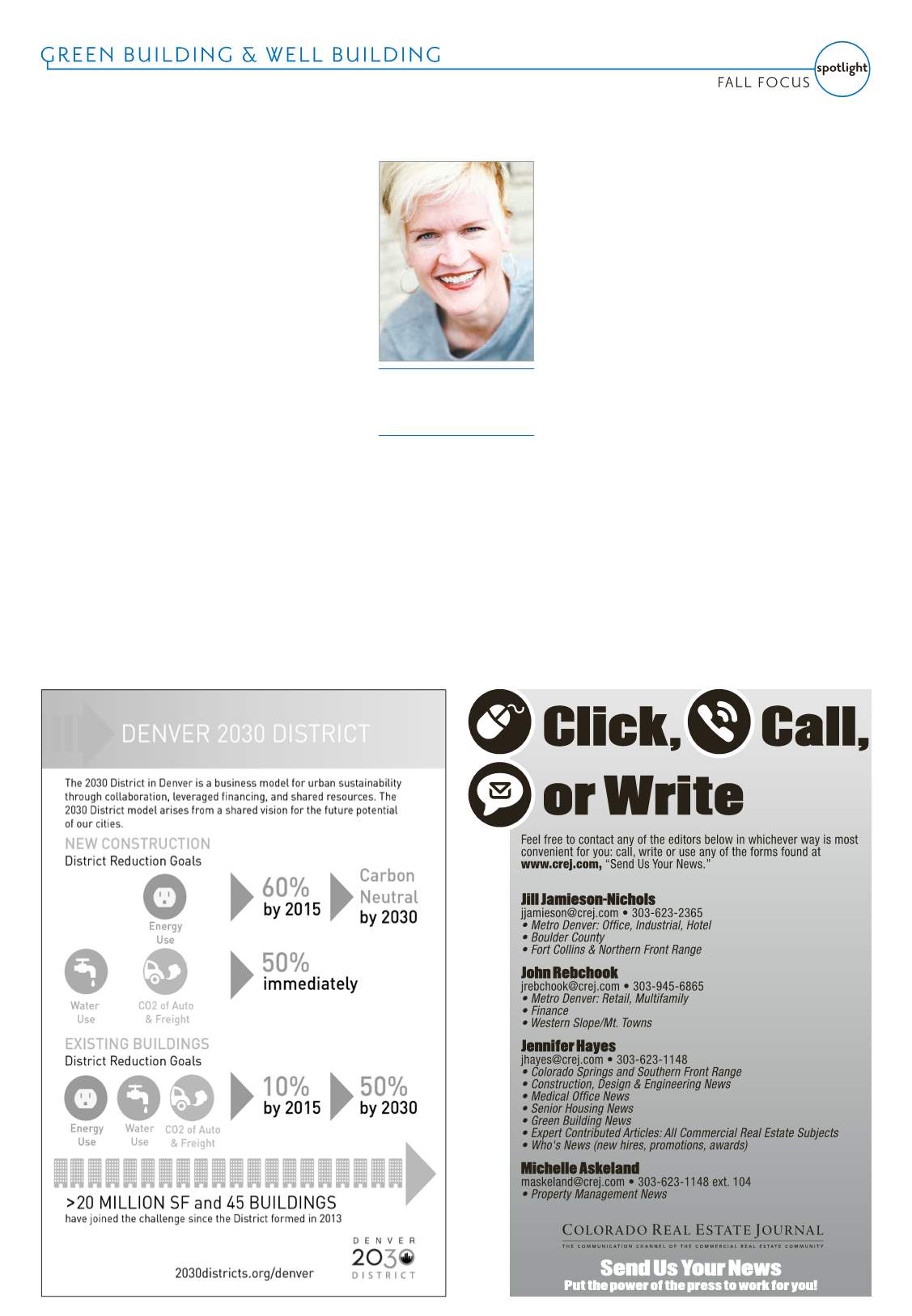
Page 22B—
COLORADO REAL ESTATE JOURNAL
—
September 2-September 15, 2015
F
or every new building
hitting the streets
today, over 100 are
20 years old or older. And
if you’re in an older model,
you’re at a disadvantage to
your competitors in newer,
shinier and more efficient
spaces because they cost less to
operate than yours.
Energy codes that feed
building codes have stepped
up significantly in the last 50
years, and yet much of the
nation’s buildings come from
that era or earlier. Multifamily
buildings built in the 1990s are
almost 9 percent more efficient
than buildings of the 1980s,
17 percent more efficient
than those built in the 1970s
and 1960s, and 23 percent
more efficient than pre-1960
housing. (Matthew Brown and
Mark Wolfe, “Energy Efficiency
in Multi-Family Housing: A
Profile and Analysis,” Energy
Programs Consortium, June
2007.) And multifamily
building requirements mirror
what’s gone on with residential,
office and retail.
So don’t let building owners
or landlords saddle you with
their inefficient buildings,
leaving you on the hook
for costly operating and
maintenance bills. The rent
may be low, but there are
probably several reasons why,
including system obsolescence
and deferred maintenance.
That could erase (with a
rebate) any rent savings you
think you’re getting.
Here are some great
questions to ask before you
buy or rent, and many of these
apply to both commercial and
residential buildings.
n
How old is the HVAC
system and what is its
efficiency rating?
Most
building inspectors will scare
up this information in an
inspection, and it’s crucial to
pay attention if you pay any
part of your utility expenses.
Efficiency ratings are a best-
case scenario in factory-perfect
conditions – how much of the
energy needed for heating
or cooling actually reaches
building occupants? (SEER
[seasonal energy-efficiency
ratio] for air-conditioners and
commercial HVAC systems, and
AFUE efficiency for residential
furnaces.) And don’t forget, old
efficiency ratings don’t function
anywhere near what they say
they do today.
On the heels of that
question, who pays for repairs?
Remember Eldon the painter
on the “Murphy Brown Show”
in the 1980s? He was Brown’s
perpetual houseguest with an
unending stream of work. If
you move into a building with
old systems, your HVAC repair
tech may become your Eldon.
Old HVAC systems rarely die –
they live on life support forever.
Nothing may light a fire under
your landlord for HVAC
upgrades faster than requiring
him/her to pick up repair bills.
And be sure to find out if the
building owner is responsible
for maintaining the system.
HVAC systems are like cars –
take care of them, and they will
operate efficiently for longer.
n
Insulation levels.
That
fab exposed brick wall in your
office may be the coolest thing
ever. And the coldest. Brick
has little-to-no insulation value,
and neither does glass. Do you
know what levels of insulation
the exterior of your building
has? Insist on an R-value
(insulation level) of at least 20,
which is code in many places.
If your building doesn’t have at
least that, you'll be on the hook
to pay higher energy bills as
you’re cuddling under blankets
at your desk, or sweltering in
summer.
n
Spaces in between.
Ceiling plenums are the
spaces between false, dropped
ceilings and floors or roofs
above. In much commercial
construction, builders use that
space as a return air cavity
because it’s cheap to build. But
plenums are also inefficient
because they are usually much
colder or warmer than the
temperature-controlled spaces
below. If your landlord won’t
“hard-duct” plenum spaces,
make sure supply pipes are
well-insulated. Otherwise, they
lose temperature from the
HVAC to your space. You pay
for that.
n
Windows.
Are windows
single-pane? If so, they could
be leaking air like sieves. This
is especially true in retail
spaces, which often have big
glass plates to display wares.
Don’t let an owner say that
the building is historical and
windows can’t be changed.
There are plenty of window
upgrades owners can make
that preserve the historic
character of a structure. Also,
look for “low-e” films, which
can significantly reduce the
amount of the sun’s heat
pounding a building.
n
Let there be light.
How
are the lights in your space?
Efficient lighting can save
as much as 40 percent on
energy costs, and light retrofits
are often one of the least-
expensive fixes with the biggest
returns. “T-value” measure
one-eighth of an inch. So T-12
fluorescent lights are 1½-inches
in diameter. T-8s are 1 inch.
Simply, T-8s and T-5s are more
efficient than T-12s, which
aren't even available anymore.
If you really want to cut down
on your lighting expenses, go
LED. They use one-tenth the
electricity of older, less-efficient
fixtures and usually pay back
within two to three years. Plus,
they look amazing.
n
Building or energy
management systems.
These can be as simple as
programmable thermostats or
as complex as building systems
controlled from across the
country via computer. Studies
show that if you work with a
programmable system and use
it, you can save as much as 15
percent on energy costs.
If you’re already in an
inefficient building, insist on
changes when you renegotiate
your lease as part of your
tenant improvements. You have
the power – use it.
Melissa Baldridge,
LEEDAPO+M
Co-owner, GreenSpot Global, Denver


